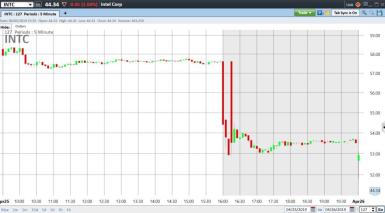After Hours Trading: Will It Work for You

Have you ever turned on the news and heard reports on how a company is doing in after-hours trading after a big earnings announcement? Have you wondered what after-hours trading actually is and how it works, and what risks are involved? Here are some answers.
What is after hours trading?
Normal market hours are 9:30 a.m. to 4 p.m. ET. After-hours trading occurs after the markets close. There is also a session prior to the market’s open which is called the pre-market session. Together both sessions are referred to as extended-hours trading.
How does it work?
Extended-hours trading is made possible by computerized order matching systems called electronic markets. An electronic market is simply a service that matches up buy and sell orders. For example, if you place an order to buy 200 shares at $45, the computer looks to see if there is an order to sell at least 200 shares at $45. If there is, the trade is done, if not, then the order will not be filled. At Schwab, clients can place orders for after-market trading and execution between 4:05 and 8 p.m. ET. Commissions and settlement times are the same as for the regular session.
There are, though, several differences between regular session trading and after-hours trading. For example, in the after-hours session, not all order types are accepted. Traders can only use limit orders to buy, sell, or short. Stop and stop-limit orders, and orders with special conditions such as fill-or-kill, immediate-or-cancel, or all-or-none, can’t be placed. Also, after-hours orders are only good for the particular session in which they are placed and do not carry over into any other session.
What are some of the advantages of after-hours trading?
There are several potential benefits for after-hours trading:
Convenience: Some traders simply aren’t able to place trades during the normal session due to their schedules. The after-hours session allows them to check out the current quotes and potentially place a trade at a more convenient time.
Ability to react to news events: Many companies release earnings after the close of the regular session. After-hours traders can immediately place trades to manage their positions without having to wait until the next day’s open and potentially miss meaningful price swings. The example below shows Intel Corp (INTC) making a big move after hours after releasing their earnings report.
Source: StreetSmart Edge®.
Examples provided are for illustrative purposes only and not intended to be reflective of results you can expect to achieve. Screenshots are historical in nature. Past performance is no guarantee of future results.
Are there any risks?
While trading in the after-hours session can offer opportunities, there are unique risks to be considered.
Uncertain prices: In the regular session, the quotes you see are consolidated and represent the best available prices across all trading venues. In the after-hours market, on the other hand, you may only see prices from one venue, and these may not reflect the prices displayed in other electronic trading systems for the same security.
Lower liquidity: Because generally fewer shares trade after hours, there can be wide spreads between the bid (the highest price offered by all buyers) and the ask (the lowest price offered by all sellers). Some stocks may simply not trade after hours.
Lack of calculation of index values: For traders dealing with certain index-based products, the lack of calculation or dissemination of index values in the after-market could put an individual investor at a disadvantage to those professionals who have access to proprietary systems that can quickly calculate index values based on individual stock prices.
The decision to trade after hours depends, of course, on your investment goals, trading style, and risk tolerance. While trading in the extended sessions is not for everybody, for those traders who understand both the potential risks and opportunities, it is certainly an avenue to explore.
Standard market vs. extended hours sessions
| Standard Market | Pre-Market and After Hours Trading |
| Orders can be placed at any time and will only be executed from 9:30 a.m. to 4:00 p.m. ET | Pre-market: Orders can be placed between 8:05 p.m. (previous trading day) and 9:25 a.m. ET and will be eligible for execution between 7:00 a.m. and 9:25 a.m. ET After-hours: Orders can be placed and are eligible for execution between 4:05 p.m. and 8:00 p.m. |
| Trading primarily occurs on exchanges (NYSE Euronext and other regional markets) and on NASDAQ through a variety of venues including market makers and ECNs | Trading occurs through a leading electronic market |
| Many order types and restrictions are accepted, including: market, limit, stop-limit, all-or-none, etc. | Only limit orders for the particular extended hours session are accepted |
| All order sizes are accepted | 25,000 shares is the maximum quantity on a single order |
| Many security types are available, including: stocks, options, bonds, mutual funds, etc. | Most listed and NASDAQ securities are available in the extended hours session |
| Different time limits are available, including: Day, GTC, IOC and FOK | All orders are only good for the particular session in which they are placed; there is no carryover into any following session |
| In general, higher trading activity means more liquidity and a greater likelihood of order execution | Lower trading activity may result in lower likelihood of order execution, wider spreads and greater price fluctuation |
| The quotes you receive are consolidated and represent the best available prices across all trading venues; market makers and specialists work to ensure customers get the best buy or sell prices displayed on NASDAQ and the exchanges | Quotes are not consolidated and represent the current prices available through the Electronic Market; as a participant in the Extended Hours Trading Network, the Electronic Market may also offer access to prices available on other participating Electronic Markets, but not necessarily all venues open for EHT |
What You Can Do Next
Learn more about trading at Schwab.
Schwab clients: Login to trade stocks.
 By
By
